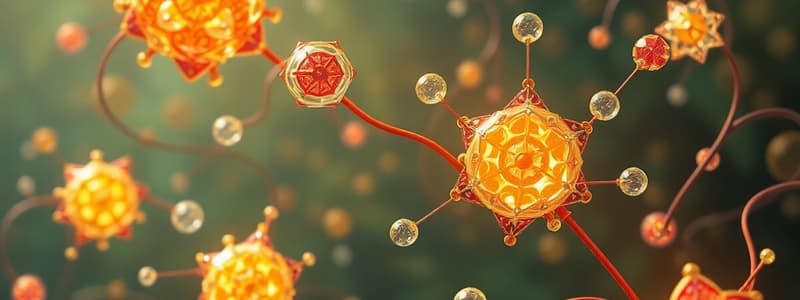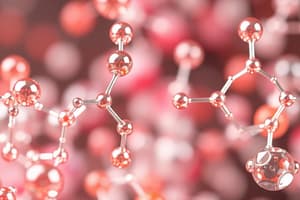Podcast
Questions and Answers
What is the overall charge of the Carbonate ion?
What is the overall charge of the Carbonate ion?
- Positive Two
- Negative One
- Positive One
- Negative Two (correct)
Ammonium has a negative overall charge.
Ammonium has a negative overall charge.
False (B)
What is the leader of the Phosphate ion?
What is the leader of the Phosphate ion?
Phosphorous
The formula for Aluminum Sulfate is Al2[SO4]3, using the ______ rule to determine the ratio.
The formula for Aluminum Sulfate is Al2[SO4]3, using the ______ rule to determine the ratio.
Which polyatomic ion contains four oxygen atoms and has a negative charge of three?
Which polyatomic ion contains four oxygen atoms and has a negative charge of three?
Match the following polyatomic ions with their overall charges:
Match the following polyatomic ions with their overall charges:
Chlorate ion has three oxygen atoms.
Chlorate ion has three oxygen atoms.
How many hydrogen atoms are present in the Ammonium ion?
How many hydrogen atoms are present in the Ammonium ion?
Flashcards
What are polyatomic ions?
What are polyatomic ions?
A group of atoms that act as a single unit with a net positive or negative charge. They can be found in nature and food.
What is the hydroxide ion?
What is the hydroxide ion?
A polyatomic ion consisting of one oxygen and one hydrogen atom with a -1 charge.
What is the nitrate ion?
What is the nitrate ion?
A polyatomic ion consisting of one nitrogen and three oxygen atoms with a -1 charge.
What is the carbonate ion?
What is the carbonate ion?
Signup and view all the flashcards
What is the chlorate ion?
What is the chlorate ion?
Signup and view all the flashcards
What is the sulfate ion?
What is the sulfate ion?
Signup and view all the flashcards
What is the phosphate ion?
What is the phosphate ion?
Signup and view all the flashcards
What is the ammonium ion?
What is the ammonium ion?
Signup and view all the flashcards
What is the crossover rule?
What is the crossover rule?
Signup and view all the flashcards
How do you name polyatomic compounds?
How do you name polyatomic compounds?
Signup and view all the flashcards
What is the 'Team Leader' in a Polyatomic Ion?
What is the 'Team Leader' in a Polyatomic Ion?
Signup and view all the flashcards
What are Polyatomic Compounds?
What are Polyatomic Compounds?
Signup and view all the flashcards
What is the 'Oh Nick the Camel' Memory Aid?
What is the 'Oh Nick the Camel' Memory Aid?
Signup and view all the flashcards
What is the Consistency of Polyatomic Ion Formulas?
What is the Consistency of Polyatomic Ion Formulas?
Signup and view all the flashcards
Why are Negative Signs Not Included in Polyatomic Compounds?
Why are Negative Signs Not Included in Polyatomic Compounds?
Signup and view all the flashcards
Can Polyatomic Compound Formulas be Simplified?
Can Polyatomic Compound Formulas be Simplified?
Signup and view all the flashcards
How do you determine the overall charge of a polyatomic ion?
How do you determine the overall charge of a polyatomic ion?
Signup and view all the flashcards
What is the 'crossover rule' in chemistry?
What is the 'crossover rule' in chemistry?
Signup and view all the flashcards
How are the chemical formulas of polyatomic compounds written?
How are the chemical formulas of polyatomic compounds written?
Signup and view all the flashcards
What is the 'Oh Nick the Camel' Memory Aid for polyatomic ions?
What is the 'Oh Nick the Camel' Memory Aid for polyatomic ions?
Signup and view all the flashcards
How consistent are polyatomic ion formulas?
How consistent are polyatomic ion formulas?
Signup and view all the flashcards
Study Notes
Polyatomic Ions
- Polyatomic ions are groups of atoms acting as a single unit, holding a positive or negative charge.
- These groups, often found in food, are given specific names.
- Each polyatomic ion has a central atom (often a nonmetal), and surrounding atoms, acting as a team.
- The overall charge of the polyatomic ion depends on the number of electrons gained or lost.
Common Polyatomic Ions
- Hydroxide (OH⁻)
- Leader: Oxygen
- Member: One hydrogen
- Overall charge: −1
- Nitrate (NO₃⁻)
- Leader: Nitrogen
- Members: Three oxygen
- Overall charge: −1
- Carbonate (CO₃²⁻)
- Leader: Carbon
- Members: Three oxygen
- Overall charge: −2
- Chlorate (ClO₃⁻)
- Leader: Chlorine
- Members: Three oxygen
- Overall charge: −1
- Sulfate (SO₄²⁻)
- Leader: Sulfur
- Members: Four oxygen
- Overall charge: −2
- Phosphate (PO₄³⁻)
- Leader: Phosphorus
- Members: Four oxygen
- Overall charge: −3
- Ammonium (NH₄⁺)
- Leader: Nitrogen
- Members: Four hydrogen
- Overall charge: +1
Memory Aid for Common Polyatomic Ions
- Oh Nick the Camel Ate a Clam for Supper in Phoenix. Say What?
- Consonants: Indicate the number of oxygen atoms.
- Vowels: Indicate the ion's overall negative charge.
Polyatomic Compounds
- Polyatomic ions combine with metals or non-metals to form polyatomic compounds.
- Determining the ratio of elements in the compound depends on their charges.
- The crossover rule helps establish the chemical formula.
- The formula reflects the elements' ratio. Brackets clarify the presence of polyatomic ions.
Example of Polyatomic Compounds
- Aluminum Sulfate (Al₂(SO₄)₃)
- Aluminum charge: +3
- Sulfate charge: −2
- Ratio (crossover rule): 2:3
- Aluminum Phosphate (AlPO₄)
- Aluminum charge: +3
- Phosphate charge: −3
- Ratio (crossover rule): 1:1
- **Lead Carbonate (Pb(CO₃)₂) **
- Lead charge; +4
- Carbonate charge: −2
- Ratio (crossover rule): 1:2
Crossover Rule
- It determines the chemical formula of compounds involving polyatomic ions.
- The charges are crossed over to create the subscripts in the formula and reduced to their lowest common factor.
Important Notes
- Brackets in formulas indicate the polyatomic ion as a single unit.
- Simplify subscripts to the lowest ratio if needed.
- Consistent practice with names, formulas, and charges is vital.
Studying That Suits You
Use AI to generate personalized quizzes and flashcards to suit your learning preferences.




